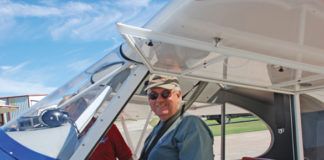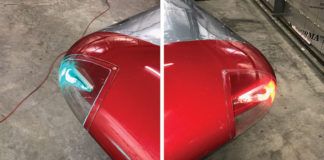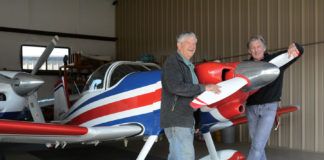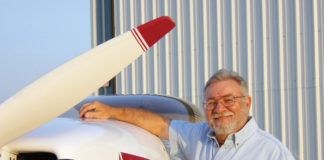A recent discussion about tail design (Wind Tunnel, March 2011) prompted several readers to ask about V-tails. Accordingly, the virtues and vices of V-tails are our subject this month.
The tail of an airplane provides stabilization and control power on two axes. In a conventional arrangement, the vertical fin provides directional (weathercock) stability, and the rudder provides yaw control. The horizontal tail stabilizes the airplane longitudinally, while the elevator (or moving the entire horizontal tail) controls the airplane in pitch.
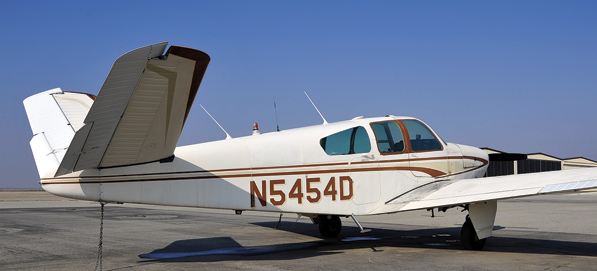
A V-tail would simplify the build with one less surface to construct, but the requirement for a mixer in the control linkage offsets that to some extent.
It is possible to replace the three surfaces of the conventional tail with a pair of surfaces mounted at a large dihedral angle, forming a V in front view. The large dihedral angle allows them to produce both lift and side force on the aft end of the fuselage, generating stability and control in both pitch and yaw. The conventional elevator and rudder control surfaces are replaced by a pair of "ruddervators," one on each tail surface, or by making both V-tail surfaces all-moving. These controls move symmetrically (both up or both down) to produce pitching moment and anti-symmetrically (one up and one down) to produce yawing moment.
At first glance, the V-tail seems to offer both reduced drag and lower weight than a conventional tail because there are two surfaces instead of three. It would appear that the total wetted area of the empennage is smaller. Also, eliminating the vertical fin reduces the number of intersections on the airplane, thus decreasing interference drag.
Upon closer examination, though, things are not as they initially appear. There are indeed fewer intersections on a V-tail airplane than on an airplane with a conventional tail, and interference drag may be slightly lower as a result. But looking more closely, we find that the drag reduction due to fewer intersections is really quite small. The total interference drag for a well-designed complete airplane amounts to only 5% to 7% of the airplane’s total drag. The elimination of the vertical fin eliminates one of five junctions, and the junction between the vertical fin and the fuselage is the lowest-interference drag junction of the five. This is because the fin is not producing much lift at any time during normal cruising flight, and the airflow over the fin is not highly accelerated like the flow over the upper surface of the wing. The drag reduction from eliminating the vertical-fin-to-fuselage junction will be quite small (considerably less than 1% of the airplane’s total drag).
The idea that a V-tail can have less total wetted area than a conventional tail because the surfaces are doing double duty also merits closer examination. The proper way to compare the two concepts is to require that the V-tail provide the same stability as the conventional tail. To do this we need to determine the "effective area" of a V-tail surface in both the horizontal and vertical directions. This will get a little mathematical, so the impatient reader can skip ahead to the conclusion, and then come back and read the math for confirmation of what is being presented.
We first consider the horizontal direction. The projected area of the V-tail surface in the top view is equal to the area of the surface times the cosine of the dihedral angle:
Sph = S cos(G)
Where S = surface area and G = surface dihedral angle.
Many people leave it at that and consider the effective area to be the projected area. In fact, this is not the case. The dihedral angle, in addition to reducing the projected area by a factor of cosine(G), also reduces the lift curve slope (rate of change of lift with angle of attack) by a similar factor. The effective area in the horizontal direction of a V-tail surface is thus the area of the surface times the cosine squared of the dihedral angle:
Seff(h) = S cos2(G).
Thus, the effective area of the V-tail surface in the horizontal plane is less than its projected area by a factor of the cosine of the dihedral angle.
In the lateral direction, things are very similar. The only thing that changes is that the area of the surface must be multiplied by the cosine squared of the quantity (90 – G) because the vertical direction is rotated 90 relative to the horizontal. It is a basic identity of trigonometry that the cosine of 90 minus an angle is equal to the sine of that angle. Thus, the effective vertical area of a V-tail surface is equal to the area of the surface times the sine squared of the dihedral angle:
Seff(v) = S sine2(G)
The total effective area of a V-tail surface is the sum of the effective vertical area and the effective horizontal area. This total effective area is the area of tail surface on a conventional tail that is required to give the same directional and longitudinal stabilization as the V-tail surface:
Seff = Seff(v) + Seff(h)
Seff = S sine2(G) + S cos2(G)
Seff = S [sine2(G) + cos2(G)]
It is a fundamental trigonometric identity that the sum of the sine squared of an angle and the cosine squared of that angle is always equal to one. Thus:
Seff = S [sine2(G) + cos2(G)] = S
Simply put, what the equation above is telling us is that to get the same stability from a V-tail as from a conventional tail, the V-tail must have exactly the same area as the conventional tail. There is actually no savings in wetted area and thus no drag reduction due to reduction in skin friction.
If a V-tail is sized to give the airplane the same stability as the conventional tail it replaces, there is little or no reduction in drag. Accordingly, using a V-tail will not measurably improve the performance of an airplane.
Let us now turn our attention to some of the disadvantages of the V-tail. Although none are truly "fatal flaws," they must be considered.
Stability and Control
One downside of V-tails is that they are not well understood by many designers. The simplistic idea of sizing the V-tail based on projected areas has led to the construction of several airplanes with undersized tails. Typically, the problem shows up as a lack of directional stability. One example from history is the "Sweet Pea" Goodyear racer in which Art Chester was killed. The airplane suffered from lack of rudder power and poor directional stability for its entire career, and this may have contributed to the final fatal accident.
Dihedral Effect and Dutch Roll
Another concern is not so much a disadvantage as it is simply something that demands attention. A V-tail produces a large amount of dihedral effect. An airplane with a V-tail will have more effective dihedral than an airplane with a conventional tail and the same wing. This can lead to the airplane having a lightly damped Dutch roll mode. This is somewhat exacerbated by the fact that, in addition to producing rolling moment due to yaw (dihedral effect), V-tails also produce rolling moment due to yaw rate. This happens because the tail is far from the CG and is pushed sideways through the air by the yaw rotation. Although it is not as big a player as pure dihedral effect, roll due to yaw rate also destabilizes the Dutch roll mode. To the occupants of the airplane, the Dutch roll will feel like a wallowing or "fishtailing" motion. It is uncomfortable when flying in turbulence and can make instrument flying a real chore.
The conventional cure for poor Dutch roll damping is to reduce dihedral effect and/or increase directional stability. The designer of a V-tail airplane should compensate for the dihedral effect of the V-tail by reducing the dihedral of the wing to get acceptable Dutch roll characteristics.
Enlarging a V-tail to increase directional stability is likely to also increase dihedral effect so much that the effect on Dutch roll damping will be negligible or unfavorable. This highlights another difficulty with V-tail design. Because the tail surfaces affect all three axes, it is difficult to make a change in the characteristics about one axis without adversely affecting another.
Adverse Roll
The cross-coupling between axes causes another aerodynamic drawback of the V-tail. When the ruddervators are deflected differentially to act as a rudder and yaw for the airplane, they also produce a rolling moment. Unfortunately, the rolling moment is opposite to the yawing moment. In other words, if you step on the left rudder pedal, the tail will try to yaw the airplane left and roll it right. A conventional top-mounted vertical fin and rudder also produce some adverse roll, but not as much as a V-tail. This adverse roll is undesirable, but in general it is small enough that the pilot can easily overcome it with the ailerons, and the airplane will feel relatively normal. On airplanes with very large V-tails, or when the tails are mounted outboard on a wide fuselage, this could be potentially troublesome.
Pitch-Up and Hung Stall
The final aerodynamic ill of the V-tail is similar to one encountered with T-tails. The surfaces of the V-tail are above the plane of the wing, so the tail will tend to enter the wing wake more and more as the airplane’s angle of attack increases. This can lead to a tendency to pitch up at the stall. It also increases the possibility that the airplane will have a stable deep-stall mode. A stable deep stall, or hung stall, is extremely dangerous, as it may not be possible to recover, and the airplane may stay stalled all the way to the ground. The problem is not quite as severe with V-tails as it is with T-tails because the V-tail surfaces enter the wing wake progressively rather than all at once. Nonetheless, the designer of a V-tail airplane should be concerned with the possibility of poor behavior at higher angles of attack.
Structures
The large dihedral effect of a V-tail also has structural implications. The tail may generate large rolling moments when the airplane is yawed or sideslipped. These rolling moments put large torsional loads on the fuselage. The extra torsional strength required of the fuselage will tend to increase its weight.
Unlike a conventional horizontal tail, the two surfaces of the V-tail cannot have a straight carry-through structure between them to carry tail bending moments. The structure inside the fuselage that picks up the tails will accordingly be heavier than the carry-through structure of a straight horizontal tail.
V-tails can also be more flutter-prone than conventional tails. Because they must move independently to control both pitch and yaw, the two ruddervators cannot be interconnected like the elevators of a conventional tail. The combination of independent ruddervators and a torsionally soft fuselage can drive a flutter mode in which the entire tail section rolls side to side, driven by the independent flapping of the control surfaces. Accordingly, as some Bonanza owners are all too aware, V-tails are much more sensitive to proper mass balancing of control surfaces than conventional tails.
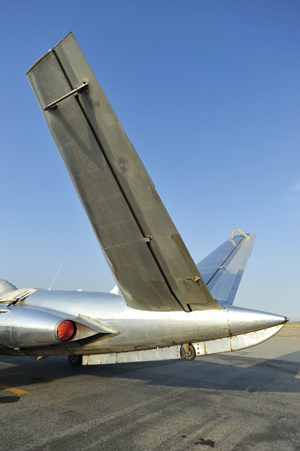
Fewer intersections on a V-tail airplane lower the amount of interference drag, but the difference is minimal.
Why Use a V-tail?
V-tails can sometimes be useful as solutions to particular configuration integration problems, but I would use them only if some consideration other than aerodynamics were driving the design.
Some sailplanes use V-tails to provide sufficient ground clearance during takeoff and landing. Sailplanes have single-wheel landing gear and sit on the ground with one wingtip resting on the ground. The resultant bank angle can cause a conventional horizontal tail to hit the ground or be so close to the ground that it will hit small bumps or rocks. Use of the V-tail eliminates this problem.
Another attractive feature for the homebuilder is that with a V-tail there is one less tail surface to build, and fewer hinges and control cables to rig. This simplicity is offset somewhat by the fact that there must be a mixer in the control linkage so that both the stick and rudder pedals can affect the deflection of the ruddervators.
V-tails and inverted V-tails have shown up on a number of unmanned aerial vehicles (UAVs). If the vehicle must fold for storage, or unfold when launched, the use of a V-tail reduces the number of surfaces that must fold/deploy. Surface deployment is always a major design issue, so this is an advantage for the V-tail configuration.
Recently, V-tails have appeared on several military airplanes, notably the Northrop Tacit Blue demonstrator and the YF-23 fighter prototype. In both cases, the V-tail was used as a way to reduce radar return rather than for any aerodynamic or performance reasons.

![]()
Barnaby Wainfan is a principal aerodynamics engineer for Northrop Grummans Advanced Design organization. A private pilot with single engine and glider ratings, Barnaby has been involved in the design of unconventional airplanes including canards, joined wings, flying wings and some too strange to fall into any known category.










